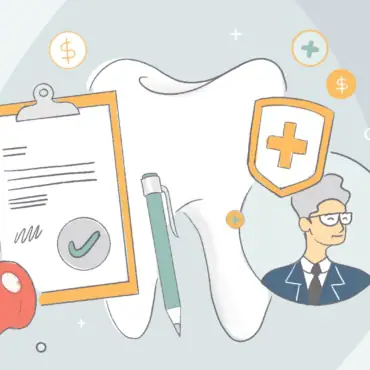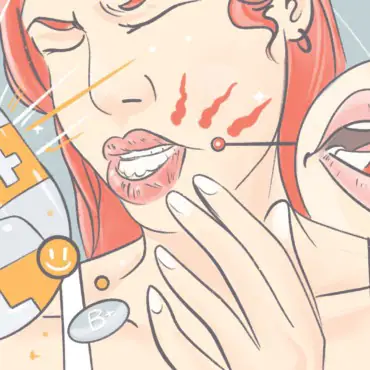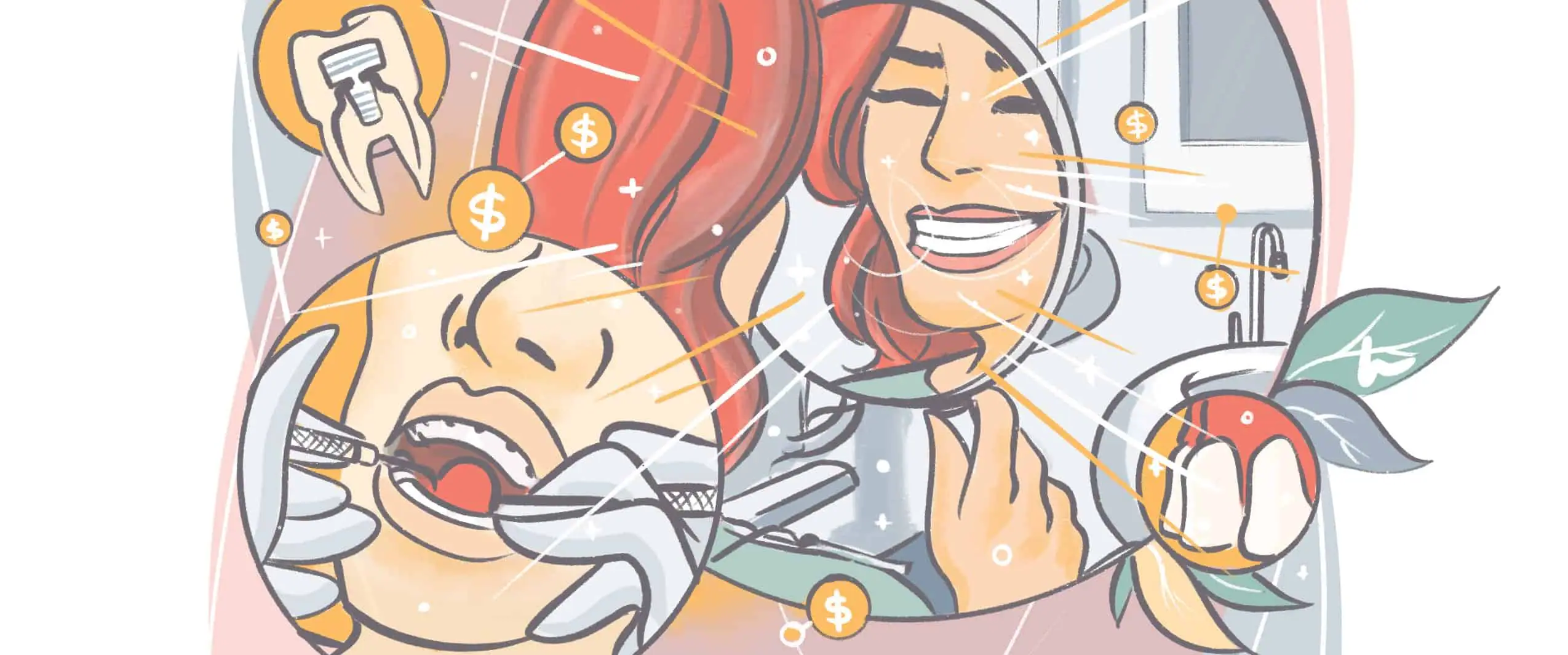How often do you think about your chompers? Sure, you probably brush your teeth once or even twice a day like your mom taught you to do. But the reality is that most of us probably just expect our teeth to do their job and don’t waste time worrying about them — until they start to hurt. Gingivitis could be the cause of this pain.
This laid-back attitude about oral health has a scary impact. In the US, a country generally noted to have high hygiene and healthcare standards, an astonishing 47.2% of adults over age 30 have some form of periodontal disease. Up the age to 65, and that statistic shoots up to 70.1%!
Our teeth could use a little more tender loving care than they are getting.
Knowledge is power, and to help you on your quest to level up your oral wellness, we’ve got some information for you about gingivitis, the extremely common precursor to periodontal disease. Read on to learn about the causes, symptoms, and treatment options available for gingivitis.
What Is Gingivitis?
What happens when you have a dirty mouth? No, not the kind that will have you adding to the swear jar. The actual dirty kind when you have that gross, sticky film on your teeth known as plaque.
Well, you might be okay for a few days, but let that plaque sit on your teeth for too long, and you’ll have a storm brewing in your mouth. Plaque both harbors bacteria and produces toxins that are harmful to your gums.
Over not that much time, the presence of built-up plaque can lead to gingivitis — an inflammation of the gums. Gingivitis is concerning because it can lead to periodontal disease and, eventually, tooth loss if left untreated.
It isn’t always easy to catch gingivitis because, in the beginning, stages it’s typically painless. Your gums may be tender, but it usually isn’t until the disease progresses that you start to feel outright pain.
What Causes Gingivitis?
Think that as long as your teeth look clean, they are clean? Think again. Plaque, the sticky stuff that is a happy home for bacteria, is invisible. Plaque that is not removed from your teeth will eventually form into tartar, a hard substance that is more difficult to remove and may require a visit to a friendly neighborhood dentist near you.
Due for a checkup?
Find a top rated dentist near you that takes your insurance.
This substance begins to irritate and cause inflammation in your gums — which is gingivitis. Left unchecked, dental caries (cavities) can result, and the gingivitis can advance into periodontal disease, which may mean you will eventually lose teeth and possibly part of your jawbone.
Though poor oral hygiene is the most common cause of gingivitis, these other factors play a significant role as well:
- Smoking or tobacco use
- Poor nutrition (particularly vitamin C deficiency)
- Certain medications (even over-the-counter ones)
- Chronic diseases (diabetes, cancer, HIV, etc.)
- Hormonal changes (including puberty, pregnancy, menopause, etc.)
- Stress
What Is the Difference Between Gingivitis and Periodontitis?
Gingivitis and periodontitis are both forms of periodontal disease, and some people may confuse them. The main difference is that periodontitis is a more advanced form of the disease that is non-reversible. Periodontitis involves bone loss, and once you’ve lost bone, you can’t get it back.
What Are the Symptoms of Gingivitis?
Gingivitis symptoms are pretty easy to spot. They include:
- Red, swollen gums
- Bleeding gums
- Sensitive gums
- Receding gums
- Tooth pain/sensitivity
- Bad breath
How Can You Prevent Gingivitis?
The best prevention for gingivitis is to maintain a proper oral health routine. Be sure that you:
- Brush your teeth twice daily, paying special attention to the gum line
- Floss daily
- Check your gums in the mirror for early signs of inflammation
- Go in for regular dental visits
- Eat a healthy, balanced diet
Can Gingivitis Go Away on Its Own?
Depending on the cause of your gingivitis, it may go away on its own. For example, if hormonal changes or stress is the culprit behind your gum discomfort, then once those problems are solved, your gingivitis may clear up with them.
However, gingivitis isn’t likely to go away on its own without a proper oral care routine. If your gums remain inflamed for more than a few days, you should consider scheduling a dentist appointment.
How Can I Get Rid of Gingivitis Fast?
In some cases, learning how to get rid of gingivitis is as simple as stepping up your oral care routine. If you’ve been getting lazy (be honest!) about brushing your teeth, tighten up that ship. Brush at least twice a day for at least two minutes.
Due for a checkup?
Find a top rated dentist near you that takes your insurance.
If you really want to go on the offense, brush your teeth after every meal or snack, and don’t forget to floss every day. It might seem a little inconvenient, but believe us when we say that brushing a few extra times is far less inconvenient than developing full-blown periodontal disease and having teeth fall out of your mouth!
You can also attack the bacterial invaders with a few home remedies that are sometimes effective for combating gingivitis.
What Are Some Home Remedies for Gingivitis?
There are a few home remedies you can try to alleviate gingivitis quickly without a trip to the dentist. Here are some common methods:
- Saltwater rinse 2 to 3 times a day
- Herbal mouthwashes (tea tree oil, lemongrass oil, aloe vera, sage, etc.)
- Oil pulling (coconut, Arimedadi, etc.)
- Clove application (also helps with pain)
- Turmeric application
Of course, it is important to keep in mind that while home remedies may cure gingivitis in some cases, they are not a substitute for visiting the dentist. If you want to keep your pearly whites healthy your whole life, you need to regularly visit a dentist who can detect more serious issues before they fully develop.
How Do Dentists Treat Gingivitis?
Once your dentist diagnoses you with gingivitis, the first step in dealing with it is to do a full professional cleaning to remove all the plaque and bits of tartar hiding out amongst your teeth.
If necessary, your dentist will also perform a procedure called scaling and root planing. Under a local anesthetic, the dentist will scrape plaque and tartar out from above and below the gum line under a local anesthetic. They’ll also smooth out any rough spots on the teeth to remove areas where bacteria can congregate and allow the gums to reattach to the teeth smoothly.
Your dentist will also check the “pocket depth” by inserting a dental probe into your gum line alongside your tooth. Healthy pockets should only be between 1 and 3 millimeters deep. Your dentist may also take some X-rays to ensure that you haven’t already begun to lose bone in areas that have deeper pockets.
Deep pockets provide areas for bacteria to live and flourish. In some cases, the dentist will perform surgery to reduce the pockets’ size and prevent future gingivitis problems.
Due for a checkup?
Find a top rated dentist near you that takes your insurance.
Antibiotics may also be used either alone or in conjunction with surgery to reduce the number of bacteria in your mouth and stuck in the pockets. Your dentist may prescribe a mouth rinse or insert a tiny gelatin-filled chip in the pockets during surgery. The chip will release the antibiotics over seven days.
Is Gingivitis Reversible?
Thankfully, yes. Gingivitis is very common, with as many as 80% of people being affected by the disease at least once in their lifetime — even if they don’t know it. Though it is a warning flag of more serious diseases, gingivitis itself is not serious as long as you seek treatment for it promptly.
As soon as you notice slightly inflamed or bleeding gums, step up your oral care habits. Brush after every meal and pay close attention to the gum line. Flossing before brushing helps to loosen bits of plaque trapped between your teeth. Also, keep in mind that flossing can cause your gums to bleed a little if you are not used to it.
If your gingivitis persists, feel free to try a few of the home remedies we mentioned earlier. But don’t let it go on for weeks. If your efforts at home are not paying off quickly, don’t wait to see a dentist. There may be an underlying problem causing your gingivitis, like tough tartar that will require professional cleaning to remove.
Where Can I Find a Dentist to Treat Gingivitis?
Need gingivitis treatment but don’t have a dentist? We can help! Our number goal is to ensure that you get the oral care you need to live a healthy, happy life. We network with skilled dentists all across North America to provide you with the perfect recommendation for your needs.
Don’t live with gingivitis and risk bone loss or losing your teeth later on. Find a dentist in your area and level up your oral wellness today








